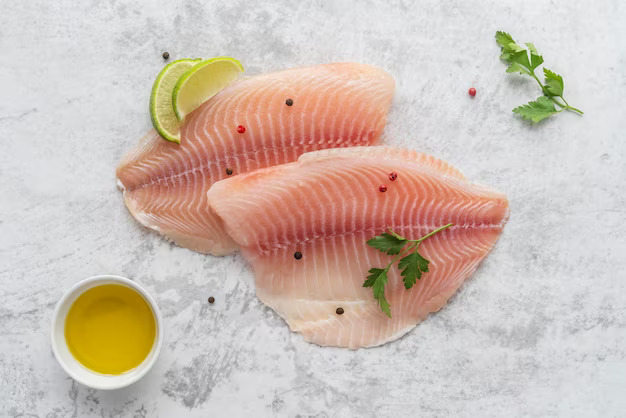The Indian mackerel, known as Chanduva is a popular fish enjoyed in coastal Indian cuisine. This oily fish packed with omega-3s offers tremendous nutritional value. Read on to learn about Chanduva fish benefits, taste, recipes, and cooking tips.
What is Chanduva Fish?
Chanduva is the Indian mackerel scientifically known as Rastrelliger. It belongs to the mackerel family and is found abundantly in the tropical waters of the Indian coastline.
Some key facts about this fish:
- Small in size – usually 8 to 12 inches long
- Streamlined, torpedo-shaped body
- Distinctive pattern of dark vertical stripes on a silver background
- Soft-textured flesh with high fat content
- Delicate flavor and taste
Chanduva is caught along the coasts of states like Kerala, Karnataka, Goa, Maharashtra, Odisha, and Tamil Nadu. It is one of the cheapest and most easily available fish in local fish markets.
Nutritional Value of Chanduva Fish
Chanduva is an excellent source of lean protein, healthy fats, vitamins, and minerals. Some of its nutritional highlights:
- Protein – 20g per 100g serving. Contains all essential amino acids.
- Omega-3 fats – Rich source of beneficial EPA and DHA omega-3s.
- Vitamin B12 – Extremely high in vitamin B12.
- Selenium – Good amounts of antioxidant mineral selenium.
- Vitamin D – Provides highly bioavailable vitamin D.
- Calcium – Contains small bones that are good calcium sources.
- Iron – Decent amounts of iron for hemoglobin formation.
- Potassium – Required amounts of muscle-benefiting potassium.
Overall, Chanduva offers a powerhouse dose of nutrients in each serving.
Health Benefits of Eating Chanduva Fish
Consuming Chanduva fish provides many science-backed health advantages:
Boosts Heart Health
Chanduva is rich in omega-3 fatty acids EPA and DHA, which improve cardiovascular function by:
- Reducing triglyceride and LDL cholesterol levels
- Preventing plaque formation in arteries
- Lowering blood pressure and inflammation
- Improving blood vessel elasticity

It protects against various heart diseases.
Enhances Brain Function
The omega-3s in Chanduva promote brain and nerve development. They improve cognition, memory, learning abilities, focus, and nerve transmission. This helps prevent neurodegenerative disorders like dementia and Alzheimer’s.
Strengthens Immunity : Selenium and vitamin D in Chanduva boost the production of white blood cells that fight infections. The omega-3s curb excessive inflammation. This fortifies the body’s immune defenses.
Builds Strong Bones : The small bones and calcium content in Chanduva fish improve bone mineral density. It prevents osteoporosis and the risk of fractures.
Supports Vision : Rich amounts of retinol and carotenoids in Chanduva maintain eye health. They reduce oxidative damage and lower risks of cataracts, macular degeneration, and blindness.
Aids Growth and Development; Chanduva is an excellent source of protein required for growth and muscle building in children. It also provides calcium, zinc, iron, and vitamins A, C, and B, which are critical for child development.
Fights Anxiety and Depression Omega-3 fatty acids reduce inflammation in the brain, which is linked to improved mood and lower risk of depression, stress, and anxiety. Chanduva also boosts happy neurotransmitters like serotonin.
Benefits Pregnant Women Chanduva provides perfect nutrition for expecting mothers. Its DHA content promotes fetal brain/nerve maturation. Other nutrients reduce anomalies and complications during pregnancy.
Consuming Chanduva fish clearly provides a wealth of health advantages for people of all ages.
Taste and Texture of Chanduva Fish
Chanduva has a soft and supple texture. It is an oily fish, so the flesh has an average fat content of 2-5%.
The natural taste is mildly sweet with very subtle flavors. It does not have a very fishy or overpowering taste.
The flesh turns white when cooked. Chanduva cooks rapidly due to its delicate structure. It can be easily pan-fried, deep-fried, grilled, or curried.
This quick-cooking fish combines well with strong spices, robust marinades, and flavorful sauces. The neutral taste readily absorbs the flavors it is cooked with.
How to Select and Store Chanduva Fish
Follow these tips for picking and storing fresh Chanduva:
- Choose fish with bright, shining eyes, vibrant red gills, firm flesh, and shiny skin with tightly adhering scales.
- Fish should have a sea-fresh smell without any ammonia odor.
- Avoid discolored fish with sunken eyes or separated meat.
- Pick freshly caught fish on ice rather than frozen fish.
- Wrap fish tightly in plastic and store in the coldest part of the refrigerator.
- Consume within 12-24 hours for best flavor and freshness.
- Wash and pat dry thoroughly before cooking to remove excess moisture.
Proper selection and minimal storage time retain the taste and nutritional quality of Chanduva.
Simple and Delicious Chanduva Fish Recipes
Here are some easy recipes to enjoy the health and flavor benefits of Chanduva fish:
Chanduva Fish Fry
Ingredients:
- 500g Chanduva fish, cleaned and cut into pieces
- 2 tbsp chili powder
- 1 tsp turmeric
- Salt to taste
- Juice of 1 lime
- Oil for frying
Marination:
- Apply salt, chili powder, turmeric, and lime juice on fish pieces
- Marinate for 20 minutes
Method:
- Heat oil in a pan over medium flame
- Add marinated fish and fry for 4-5 minutes each side
- Fry until golden brown and serve hot, garnished with lime wedges
Chanduva Curry
Ingredients:
- 750g Chanduva fish chunks
- One onion, chopped
- Five cloves garlic, chopped
- 1-inch ginger, chopped
- Two tomatoes, chopped
- 1 tsp cumin seeds
- 1 tsp coriander powder
- 1 tsp garam masala
- 2 tbsp coconut oil
- Salt to taste
- Chopped coriander for garnish
Method:
- Heat oil and sauté cumin seeds, onion, garlic, ginger
- Add tomatoes and spices and cook till mushy
- Add fish chunks and salt
- Simmer for 8-10 minutes till the fish is cooked through
- Garnish with coriander and serve with rice
Chanduva Fish Curry
Ingredients:
- 750g Chanduva fish steaks
- 2 tbsp tamarind pulp
- One onion, sliced
- Five garlic cloves, crushed
- 1-inch ginger, chopped
- Two green chilies, sliced
- 1 tsp chili powder
- 1⁄2 tsp turmeric
- Salt to taste
- 2 tbsp coconut oil
- Chopped coriander for garnish
Method:
- Marinate fish with salt, chili powder, and turmeric for 20 mins
- Heat oil and sauté onions, garlic, ginger, green chilies
- Add tamarind pulp and spices and cook for 2 minutes
- Add fish steaks and simmer for 6-8 minutes
- Garnish with coriander and serve with rice
The simple spices and cooking methods let the sweet flavor of Chanduva shine through in these curry recipes.
Healthy Cooking Tips for Chanduva Fish
- Use healthy cooking oils like coconut oil or olive oil rather than deep frying.
- Avoid overcooking the fish to prevent loss of nutrients.
- Skewer or wrap in banana leaf and grill instead of frying for flavorful, low-fat recipes.
- Prepare light curries using minimal oil and coconut milk instead of heavy, creamy sauces.
- Add antioxidant-rich spices like turmeric, garlic, and ginger to boost benefits.
- Combine with vitamin-rich vegetables like spinach, kale, and tomatoes for nutritious meals.
- Enjoy the head, bones, and liver, which are packed with vitamins, minerals, and collagen.
With some simple tweaks, Chanduva fish recipes can be made into super healthy dishes to enjoy regularly.
Conclusion
The Indian mackerel Chanduva is more than just a cheap and locally available fish. This omega-3-rich seafood is brimming with high-quality protein, vitamins, and antioxidants that provide far-reaching health benefits. When cooked with care to preserve nutrients, Chanduva fish can transform daily meals into nutritious powerhouses.
Related blogs









